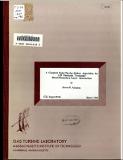A coupled Euler/Navier-Stokes algorithm for 2-D unsteady transonic shock/boundary-layer interaction
Author(s)
Allmaras, Steven R. (Steven Richard)
Download21503969.pdf (13.90Mb)
Alternative title
Unsteady transonic shock/boundary-layer interaction, A coupled Euler/Navier-Stokes algorithm for 2-D
Other Contributors
Massachusetts Institute of Technology. Gas Turbine Laboratory
Metadata
Show full item recordAbstract
This thesis presents a coupled Euler/Navier-Stokes algorithm for solving 2-D unsteady transonic flows. The flowfield is described by a Defect formulation, where separate Euler and Navier-Stokes algorithms are used on overlapping grids and are coupled through wall transpiration fluxes. The work is separated into three major contributions. The first contribution is a new algorithm for the solution of the 2-D unsteady Euler equations. The algorithm incorporates flux-splitting to capture shocks crisply and with minimal oscillations. To reduce numerical errors, grid independent second order accuracy is achieved for both steady and unsteady flows. This is done by a formulation in which both solution averages and gradients are stored for each cell. The scheme allows no decoupled modes; hence, no explicitly added artificial is necessary. The second contribution is a Thin-Shear-Layer Navier-Stokes algorithm for viscous regions. The algorithm uses two-point differencing across the boundary layer, which is second order accurate for both inviscid and viscous terms on nonsmooth grids. Fluxsplitting is used for the streamwise discretization to capture shocks. The spatial discretization of this scheme also admits no decoupled modes and does not require added artificial dissipation. A semi-implicit time integration is employed, which allows a time step determined by the streamwise grid spacing only. The algorithm uses a dynamic coordinate rescaling to evolve the viscous grid to the changing boundary layer thickness. The final contribution of the work is a explicit relaxation procedure for coupling the Euler and Navier-Stokes algorithms together. The coupling is through boundary conditions-specified outer edge values for the viscous solution and wall transpiration fluxes for the Euler solution. Computational results are presented for a series of duct geometries. The test cases are used to demonstrate the accuracy of the Euler algorithm, the Navier-Stokes algorithm, and the fully coupled algorithm. Results are compared with analytic theory, experimental results, and other computational methods.
Description
March 1989 Originally issued as: Thesis (Ph. D.)--Massachusetts Institute of Technology, Dept. of Aeronautics and Astronautics, 1989 Includes bibliographical references (pages 238-243)
Date issued
1989Publisher
Cambridge, Mass. : Gas Turbine Laboratory, Massachusetts Institute of Technology, [1989]
Series/Report no.
GTL report #196